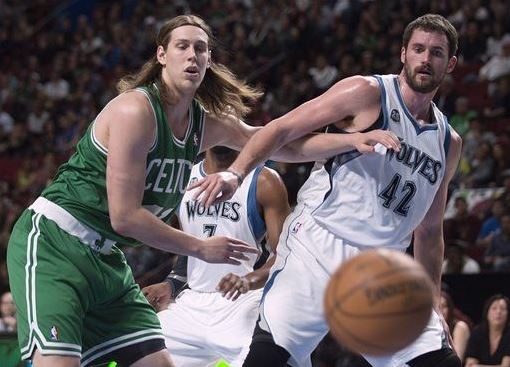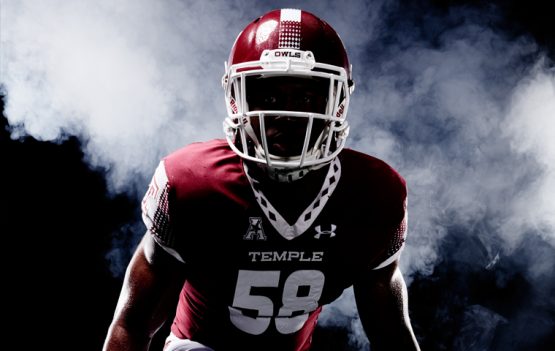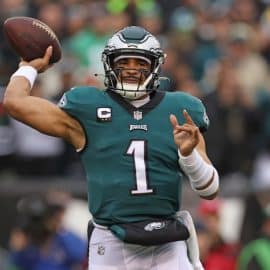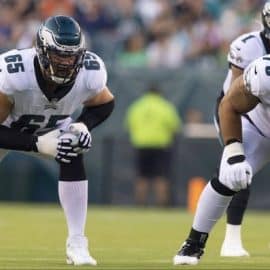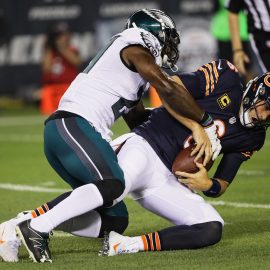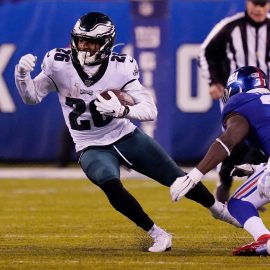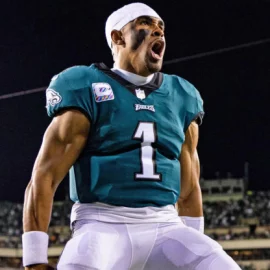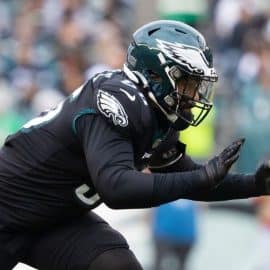Remember when the Eagles were known to be a not-so-good power running team? Since then, they have gone to a zone-blocking strategy with their offensive line, and it seems to be paying dividends.
I dug up an old article by Kevin Donovan from November of 2008 to illustrate the point. Donovan wrote this for the Examiner.com, and it was centered upon a TD catch by Todd Herremans which was achieved off a play designed to look like a power run formation, at 3rd-and-goal at the two-yard line against Seattle…
This memorable play involved the starting left guard (Todd Herremans, #76 at the time) lining up outside the starting right tackle and inside the third string tight end. Pretty uncommon formation.
But it was successful, Todd Herremans’ touchdown reception got a standing ovation from all the big boys who man the trenches. What’s even more impressive? He made the catch with a dislocated finger. Let’s break down what happened…
Herremans (76) is announced as an eligible receiver. He lines up next to Jon Runyan with Matt Schobel (89) to his right. The backfield is split with Dan Klecko (49) on the left and Correll Buckhalter (28) lined up deep on the right. Prior to the snap Klecko shifts to his right in front of Buckhalter.
At the snap Herremans blocks the defensive end in front of him, Schobel releases to the second level and engages a linebacker, Klecko takes two steps forward like he’s setting a lead block, and McNabb (5) and Buckhalter look to make the handoff.
Playfake! Klecko breaks off and runs a drag route a yard in front of the goal line. Schobel runs a parallel route at the back of the end zone. Herremans releases from his block, drives two steps forward, pivots, and gets the ball right in his numbers. Touchdown!
Although running a play like this was a sign that Andy Reid and Co. still could not figure out the power running game at that point, it was a good sign that they were willing to find ways to use this perceived weakness to manipulate a defense.
The Seahawks (and everyone else following the NFL) knew the Eagles were miserable in power run scenarios. On this play Seattle deploys a seven man defensive line, with two linebackers, and two safeties. Those defensive players face an odd heavy set with the additional lineman. Certainly they sense trickery afoot, with Herremans announced as eligible, but the formation still indicates a two-yards-and-a-cloud-of-dust type play call. The Eagles sell the fake so well that literally every Seahawks defender is sprinting forward at the snap. By the time they see the fake handoff and Klecko leaking out into his route, Herremans is already turning to catch the pass that changed the game’s momentum.
Give the Eagles points for creativity and execution. By flaunting their weakness in a crafty formation and play, the offense turned a liability into an asset.
Jump to 2011 and 2012:
The old offensive line of the Eagles is gone except for Herremans, and the old OL prototype of massive pass-blockers who didn’t execute power run plays is now replaced by smaller but faster guys. Of course, “small” is a relative term when you’re comparing a 310-pound guy to a 340-pound guy. But hopefully you get the point.
So here’s the new reality of the Eagles running game:
Historically, offensive line play in football involved one-on-one confrontations, with burly offensive linemen overpowering their defensive counterparts to open running lanes. Problem was, defensive linemen and some outside linebackers became as big and quick as the best of the traditional offensive linemen like Jon Runyan and Tra Thomas (See Exhibit “A”, Haloti Ngata….) So teams without big, powerful offensive lines devised the zone blocking scheme to benefit smaller, more athletic linemen who can use speed and leverage to their advantage. When zone blocking, offensive linemen block gaps, or areas of the field between blockers, and not necessarily one specific defender. While individual schemes may vary, zone blocking relies on a few general rules…
Covered…
In a zone blocking scheme, the offensive lineman’s responsibilities change depending on whether he’s covered (when a defender is lined up directly in front of him) or uncovered. A covered lineman still must block his assigned defender, just like in a traditional blocking scheme. However, because it’s a zone, the offensive lineman blocks the gap on the play side. In other words, if the play calls for the run to go right, the lineman will step into the gap and block the right side of the defender, creating a seal.
Uncovered…
If the offensive lineman is uncovered, meaning that no defender is in front of him, his job in a zone scheme is to slide into the play-side gap, secure the area, offer double-team assistance to his play-side teammate and then quickly move into the second level to engage any free linebackers or defensive backs. Uncovered offensive linemen, and the decisions they make, are critical to zone blocking success.
Outside…
Zone blocking may be either inside or outside. In outside zone blocking, the offensive linemen try to gain leverage on the outside of the defender, forging a seal for the runner along the sideline. If defenders recognize the outside movement and overplay in that direction, the offensive linemen use the defender’s momentum against him, driving him all the way to the sideline and opening a cutback lane for the runner.
Inside…
Zone blocking also attempts to use the defender’s momentum to create a cutback lane, except the designed hole falls between the tackle and guard and not outside the tackle. The same basic rules govern inside zone blocking, with the linemen double-teaming according to whether or not they’re covered. The main difference in inside zone blocking is that the running back reads the outside hip of the play-side guard, ideally cutting the ball between the guard and tackle.
Warning…
Zone blocking features a lot of double-team blocks, with an uncovered lineman stepping in to help his play-side teammate. When moving across to block the already engaged defender, the double-teaming lineman must block the defender above the waist. Cutting an engaged defender below the waist or knee can be extremely dangerous for the defender, creating an increased risk of injury. Because of the seriousness of the infraction, officials will call a chop block and penalize the offensive team 15 yards.
Okay, so zone-blocking has come to Philly and looks like it’s here to stay. Hard to argue against it with the yardage Shady McCoy put up last season running with it. Obviously there’s a lot of reading and smarts required of the offensive linemen in the new order. Just as important is the physical side of it: the slightly smaller, more agile and mobile big athlete with the long-distance runner’s stamina to match
I’ll be watching the Eagles draft with increased attention to the offensive linemen they may select. It appears the organization is committed to transforming into a zone-blocking running game. It is not a fad. Ask Arian Foster.
Personally I’ll miss the blocks-of-granite drive-blocking lines of the Eagles’ past…of the Antoine Davis mold (RT, ’90’s), and Lester Holmes (RG, ’90’s), guys like that who blocked straight ahead for power running backs like Ricky Watters. But those days of classic yet less-sophisticated defensive challenge are long past.
It took almost a decade to figure it out, but I believe the zone-block run philosophy is the new “power run” answer for the Eagles.
Add The Sports Daily to your Google News Feed!
